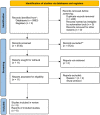Virtual reality in chemotherapy support for the treatment of physical functions, fear, and quality of life in pediatric cancer patients: A systematic review and meta-analysis
- PMID: 37124795
- PMCID: PMC10130570
- DOI: 10.3389/fpubh.2023.1039720
Virtual reality in chemotherapy support for the treatment of physical functions, fear, and quality of life in pediatric cancer patients: A systematic review and meta-analysis
Abstract
Background: Appropriately selected complementary therapies, such as virtual reality (VR) and active video games (AVG), provide support to young patients during the process of cancer treatment. Therefore, this systematic review with meta-analysis aimed to analyze the effects of VR and AVG on fear, physical functions, and quality of life.
Methods: A systematic search was performed independently in Scopus, PubMed, Embase, Web of Science and Cochrane Library electronic databases for relevant randomized controlled and crossover studies. From a total of 5,963 records, 11 met the inclusion criteria. After full-text screening two publications were excluded, yet six studies were included in the quantitative analysis because three studies had a large discrepancy in their measured outcomes. For methodological quality assessments, the RoB2 software program was used, while RevMan 5.4.1 was used for statistical analysis and meta-analysis. Standard Mean Difference (SMD) outcome measures were used for the analysis. Statistical heterogeneity was assessed using the I2 statistic with a cut-off value of 50% considering intervention and outcome measures.
Results: Our systematic review includes six randomized controlled studies and three randomized crossover studies. The participants represented both sexes and were children and adolescents (<18 years old) with a diagnosis of cancer. The analysis of the results allows for a careful conclusion that VR has the potential to become an accessory tool in rehabilitation and oncologic treatment. All of the included studies noted a significant advantage of this intervention.
Conclusion: VR has the potential to be an effective and important tool in the oncologic treatment of children. VR immerses the patient, and as a result, produces a distraction that effectively reduces pain associated with standard oncologic care procedures in children. However, this systematic review and meta-analysis highlights the need for more research into the use of VR as support for pediatric oncologic care.
Systematic review registration: PROSPERO database (https://www.crd.york.ac.uk/prospero/display_record.php?RecordID=319000), CRD42022319000.
Keywords: anxiety; chemotherapy; childhood cancer; fear; pain; pediatric patients; virtual reality.
Copyright © 2023 Czech, Rutkowski, Kowaluk, Kiper and Malicka.
Conflict of interest statement
The authors declare that the research was conducted in the absence of any commercial or financial relationships that could be construed as a potential conflict of interest.
Figures
References
Publication types
MeSH terms
LinkOut - more resources
Full Text Sources
Medical
Miscellaneous







